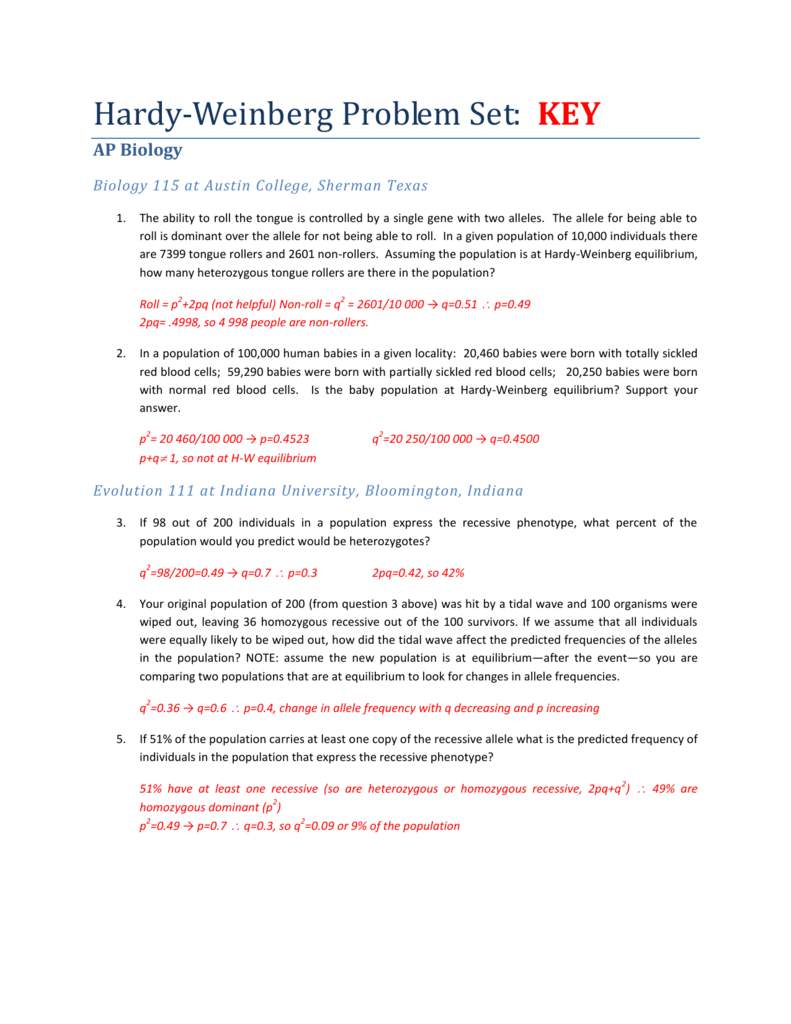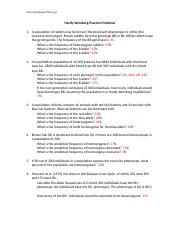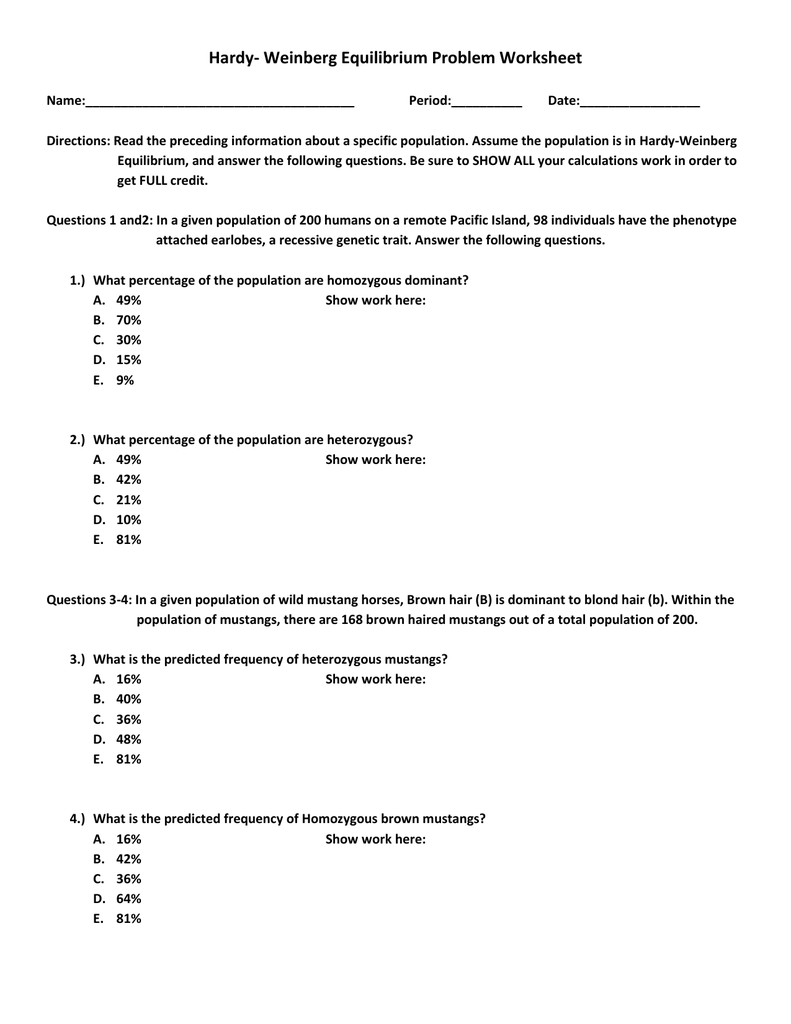Hardy Weinberg Problem Set / KEY- Fall 2015- Problem Set 2-Hardy-Weinberg - Problem Set ... / These frequencies will also remain constant for future generations.
Hardy Weinberg Problem Set / KEY- Fall 2015- Problem Set 2-Hardy-Weinberg - Problem Set ... / These frequencies will also remain constant for future generations.. P2+2pq+q2 = 1, where 'p' and 'q' represent the frequencies of alleles. Follow up with other practice problems using human hardy weinberg problem set. However, for individuals who are unfamiliar with algebra, it takes some practice working problems before you get the hang of it. The principle behind it is that, in a population where certain conditions are met (see below), the frequency of the. Key ap biology biology 115 at austin college, sherman texas 1.
Allele frequencies in a population will not change from generation to generation. The principle behind it is that, in a population where certain conditions are met (see below), the frequency of the. Individuals producing seed without an awn are homozygous recessive, those with a long awn are homozygous dominant, and those with a medium awn are heterozygous. The frequency of two alleles in a gene pool is 0.19 (a) and 0.81(a). Below is a data set on wing coloration in the scarlet tiger moth (panaxia dominula).

P2+2pq+q2 = 1, where 'p' and 'q' represent the frequencies of alleles.
Some basics and approaches to solving problems. If given frequency of dominant phenotype. P2 + 2pq + q2 = 1 p + q = 1 p = frequency of the dominant allele in the population q = frequency of the recessive. Follow up with other practice problems using human hardy weinberg problem set. Key ap biology biology 115 at austin college, sherman texas 1. P2+2pq+q2 = 1, where 'p' and 'q' represent the frequencies of alleles. What assumption(s) did you make to solve this problem? Use the hardy weinberg equation to determine the allele frequences of traits in a dragon population. These data sets will allow you to practice. Learn vocabulary, terms and more with flashcards, games and other study tools. The horizontal axis shows the two allele frequencies p and q and the everything is set equal to 1 because all individuals in a population equals 100 percent. Some or all of these types of forces all act on living populations at various times and evolution at some level occurs in all living organisms. This is a classic data set on wing coloration in the scarlet tiger moth (panaxia dominula).
Individuals producing seed without an awn are homozygous recessive, those with a long awn are homozygous dominant, and those with a medium awn are heterozygous. Therefore, the number of heterozygous individuals 3. Follow up with other practice problems using human hardy weinberg problem set. P2+2pq+q2 = 1, where 'p' and 'q' represent the frequencies of alleles. Remember that these questions assume that all of the assumptions.

If given frequency of dominant phenotype.
A population of ladybird beetles from north carolina a. Allele frequencies in a population will not change from generation to generation. If given frequency of dominant phenotype. What is the frequency of heterozygotes aa in a randomly mating population in which the frequency of all dominant phenotypes is 0.19? The frequency of two alleles in a gene pool is 0.19 (a) and 0.81(a). These frequencies will also remain constant for future generations. P added to q always equals one (100%). Answer key hardy weinberg problem set p2 + 2pq + q2 = 1 and p + q = 1 p = frequency of the dominant allele in the population q = frequency of the recessive allele in the 2pq = 2(.98)(.02) =.04 7. This is a classic data set on wing coloration in the scarlet tiger moth (panaxia dominula). Use the hardy weinberg equation to determine the allele frequences of traits in a dragon population. Start studying hardy weinberg problem set. Remember that these questions assume that all of the assumptions. These data sets will allow you to practice.
P2 + 2pq + q2 = 1 p + q = 1 p = frequency of the dominant allele in the population q = frequency of the recessive. These data sets will allow you to practice. As with any other type of mathematics the best way to master a new skill is by practice. Below is a data set on wing coloration in the scarlet tiger moth (panaxia dominula). Start studying hardy weinberg problem set.

What is the frequency of heterozygotes aa in a randomly mating population in which the frequency of all dominant phenotypes is 0.19?
P2 + 2pq + q2 = 1 p + q = 1 p = frequency of the dominant allele in the population q = frequency of the recessive. Answer key hardy weinberg problem set p2 + 2pq + q2 = 1 and p + q = 1 p = frequency of the dominant allele in the population q = frequency of the recessive allele in the 2pq = 2(.98)(.02) =.04 7. The frequency of two alleles in a gene pool is 0.19 (a) and 0.81(a). P added to q always equals one (100%). Use the hardy weinberg equation to determine the allele frequences of traits in a dragon population. P2+2pq+q2 = 1, where 'p' and 'q' represent the frequencies of alleles. This is a classic data set on wing coloration in the scarlet tiger moth (panaxia dominula). The horizontal axis shows the two allele frequencies p and q and the everything is set equal to 1 because all individuals in a population equals 100 percent. These data sets will allow you to practice. This set is often saved in the same folder as. Some or all of these types of forces all act on living populations at various times and evolution at some level occurs in all living organisms. The principle behind it is that, in a population where certain conditions are met (see below), the frequency of the. I will post answers to these problems in a week or two.
Komentar
Posting Komentar